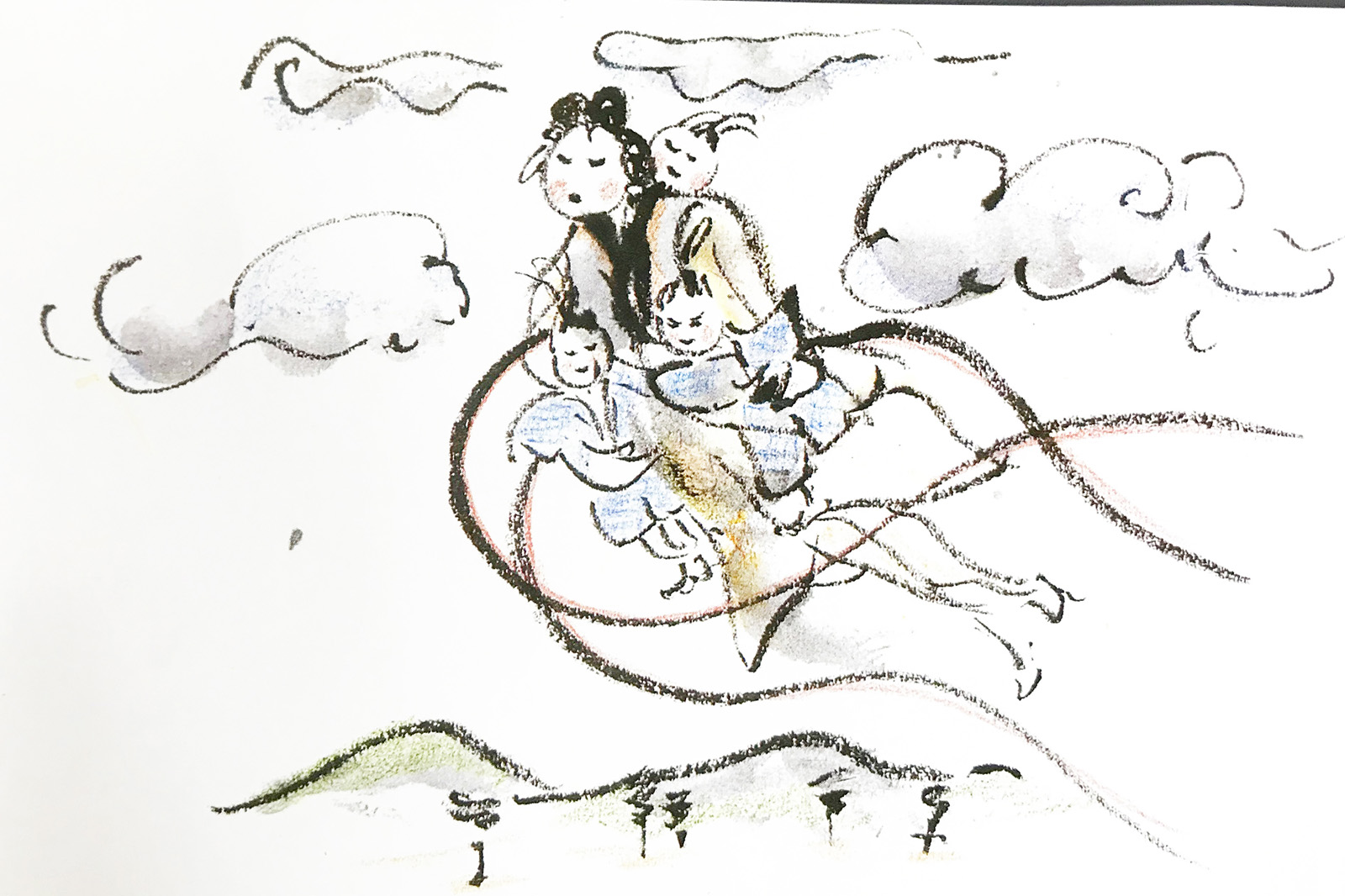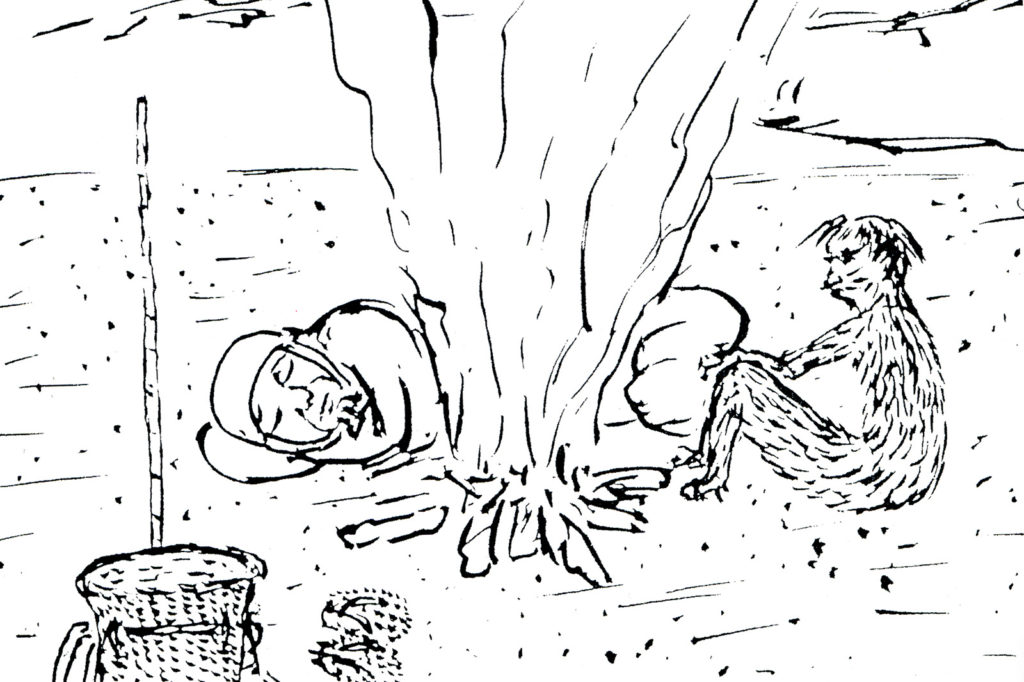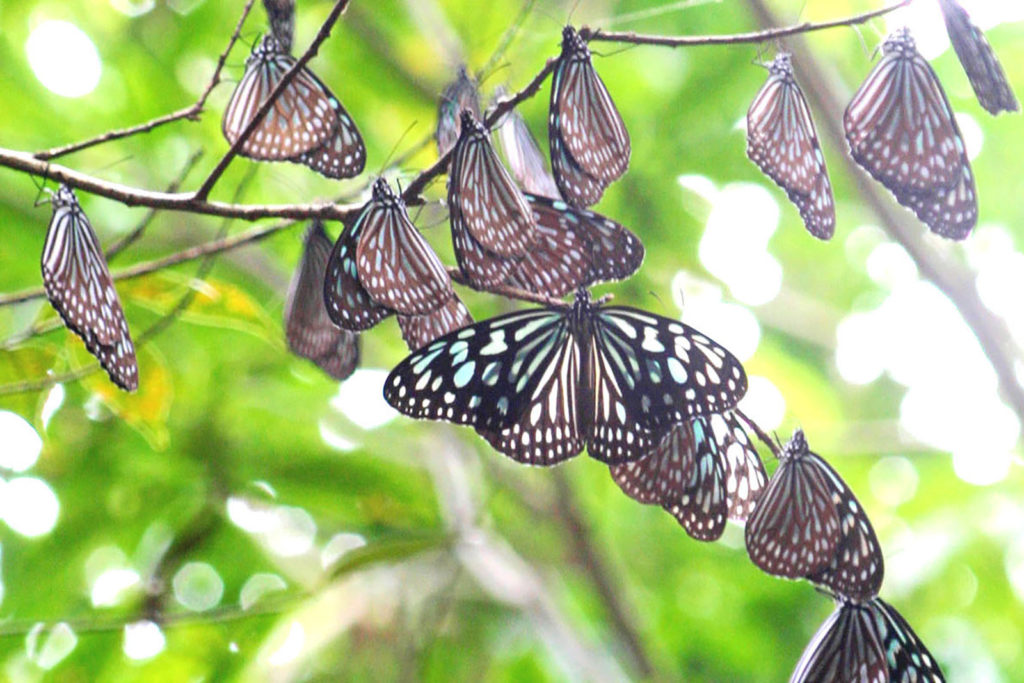
Storied Islands
Folk Tales of Amami Islands
Kikaijima
The Ryugu Bride

Illustration of Kikaijima Folk Tale The Ryugu Bride
Once upon a time, a young, poor boy who sold flowers was walking along the beach clutching the flowers he could not sell. He decided to offer them to the Neriya god (Dragon King) and tossed them into the sea. When he did, a sea turtle emerged from the waves to thank him and take him deep down to Neriya, the palace of Ryugu the Dragon King.
The young boy married one of Ryugu’s daughters and spent 3 dreamlike days in the palace. When the couple returned to the beach, they found 3 years had passed on dry land.
The Ryugu bride brought the boy’s dead mother back to life, and used the Mallet of Life to build a house, storehouse and create a rice harvest. She made her husband a wealthy man, and they lived in harmony.
Many feudal lords who heard of these wonders issued challenges designed to steal the Ryugu bride away, but her great wisdom thwarted each attempt.
This finally came to an end when a throng of tiny samurai popped out from a small box and slashed the feudal lords with their swords. When they did, seawater rose and formed into a mighty wave that came forward to cover the feudal lords’ bodies and receded, dragging every last one back into the sea.
Amurounagu (Maiden Descended From Heaven)
Long, long ago, a celestial maiden came down from heaven to bathe in the river. A man who happened to pass by was overcome by her beauty. Seeing the maiden’s enchanted gown hung on a tree, he decided to hide it from her. The man told her he would only give it back if she became his wife, so that’s what the celestial maiden did. She bore him three children in the next seven years. One day, the oldest child gave the youngest child a piggy back ride and sang a lullaby about the location of the enchanted gown to him. Hearing the song, the maiden was filled with joy and climbed into the family storehouse where the man had it hidden. She put on the gown that enabled her to ascend back up into heaven with her three children. She left a note telling her husband that he, too, could come up into heaven. But the maiden’s parents didn’t like him and forced him to do hard jobs one after another. The celestial maiden used her wisdom to solve one problem after another for the man. But one day, the man didn’t follow his wife’s advice to cut a winter melon horizontally, and instead cut it vertically as her parents had told him. Just then, a massive flood flowed from the cut and washed the man away. And that was how the Milky Way began. Ever since, the celestial maiden and the man have only been able to meet once a year on July 7th.

Amurounagu illustration
Amami Oshima
The Myth of Amamiko
This is a story that took place once upon a time when the Amami Islands were still floating on the waves of the sea. From the heavens, the king of the gods ordered the goddess Amamiko and the god Shinireko to remake the islands that drifted like jellyfish on waves into “an island easy to live on.” The two gods gripped a magical trident granted them for the task, and slowly stirred the floating islands. The islands quickly began to form into a mass before their eyes. The two gods then stepped down onto the highest mountain, Amandy. They created good, solid ground with god-given soil and stone from heaven. They “planted trees and plants to make it a beautiful island” as the king bid them. The trees grew thick to keep the waves back, and created a beautiful lush island where flowers and birds live. And that was how Amami Oshima began.
Eventually, the two gods got married and were blessed with three boys and three girls. The eldest son was the founding male sovereign, the second son the founding of a line of Aji feudal lords, and the third son the founding of the farmers. Of the girls, the eldest was first of a line of monarchs (highest goddesses), the second daughter became a Noro shaman (a hereditary female village medium), and thereafter human beings were born and the world of people began. Amamiko ascended into heaven to receive seeds to give to the people and teach them how to cultivate crops, weave and farm. Overjoyed with the harvest and abundance Amamiko’s teachings brought them, the villagers started Arasetsu and other rituals in worship of the gods of heaven.
Okinoerabujima
Myth of How the Island was Born
Once upon a time in this land, if you stepped on the northern end of the island, the south end would stick up, or if you stepped on the south end, the north would stick up, as it seesawed back and forth on the waters. This bothered Shimakouda and Kunikouda, who went to the king of the gods to discuss the problem. The king of the gods said, “Place black rocks on the east coast and white rocks on the west coast,” and when the two did as he said, the earth stopped moving up and down and took the shape of an island. When they went to talk to the king of the gods about creating humans, he taught them, “make the shape of a person in the dirt, and blow your breath over it,” and that’s what they did to make human beings. The pair also consulted with the king of the gods because they could not have children. When he advised the male Ihiri to build his house windward and the female Unari to build hers downwind, that’s what they did. And they were blessed with children. For food, he told them: “Go to Niragashima (Palace of the Dragon King) and get some grain seeds.” They went to get them, but the great king Ufunushi refused to give them any because the festival for the first harvest of the season was not yet over. Shimakouda and Kunikouda tried to steal a sheaf of rice and run home with it, but were chased, tackled and killed.
Worried that the pair had not come home, the king of the gods dispatched a messenger to Niragashima. Thanks to a magical potion the messenger gave them to drink, the two were revived and came back to the island. Once he heard the full account, the king of the gods told the couple to go once again to Niragashima to return the stolen rice. Once they did, the people concluded the festival for the first harvest of the season, and the pair could receive a sheaf of rice. From then on, Okinoerabujima was rich in a bounty of rice as well as children and grandchildren.
Yoronjima
The Sun’s Child
The story that the sun made a human female give birth to its child has long been passed around the Amami Islands. This Omoimatsugane myth is the most important folklore among “yuta” deity festivals on Amami. It tells the story of the sun god Tedakumuganashi.

The Sun’s Child illustration
Once upon a time there lived a stunningly beautiful girl named Omoimatsugane on the Island of Amami. Men on the island were overwhelmed by her glittering beauty and could not muster up enough courage to approach her. One day, when the girl was tilling the farm under the scorching sun, a gleam of light suddenly flashed and came into Omoimatsugane’s body. She was knocked down, and when she came to, she found herself being laid in her house. As days went by, the girl’s belly gradually grew, but she had no idea who the baby’s father was.
Twelve months later, a baby boy was born. He was named Kanenomatarabe, and he grew up healthy and excelled at everything he did. One day he came to know that his father was the sun god Tedamuganashi and he went up to heaven to confirm it. But the god was furious, saying that he had no recollection of such, and ordered the boy be fed to an ogre. When the ogre tried to eat the boy, it could not get close to him for all his dazzle, and eventually the ogre fell to its knees and started praying. The god, after hearing this from his vassal, finally admitted that the boy was his son, and told the girl and her son to wait on the ground to receive food. When Kanenomatarabe came back down to the ground and was working as a cowherd, the fortune-telling book Ozoushi descended to him from heaven. Kanenomatarabe became the first fortune teller and his mother the first yuta shrine maiden.
Illusts/ Nozomi Sakakibara & Kosaku Club



